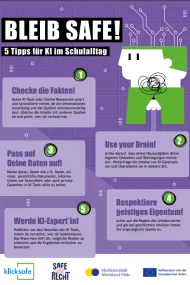The new klicksafe flyer informs young people on how to deal with AI tools in the school context. It explains what they should consider when using ChatGPT & Co. for their tasks. Tips include fact-checking and source-checking the generated content, independent thinking and engaging with the AI output. The flyer also covers the topics of copyright and data protection and shows students what they need to be aware of in this regard. In conclusion, the aim is for everyone to benefit from the advantages of such AI tools in the best possible way by understanding how they work and what the associated limitations and risks are.
1) Check the facts! Use AI tools or online resources smartly and always check if the information is reliable and the sources trustworthy. Compare the content with other sources and check who wrote it.
2) Use your Brain! Make sure that your homework contains your own thoughts and reflections. Question the content of AI generators and revise it in your style.
3) Watch your data! Remember not to share data such as name, address, personal documents, health information or even private thoughts in AI tools.
4) Respect intellectual property! Respect copyright rules and always credit the original source for protected content.
5) Become an AI expert! Take advantage of AI tools by understanding how they work. This know-how will help you identify potential risks and evaluate the results more critically.
The flyer unfolds into a poster for e.g. the classroom with a more detailed version of the five tips.
About this resource
The new klicksafe flyer informs young people on how to deal with AI tools in the school context. It explains what they should consider when using ChatGPT & Co. for their tasks. Tips include fact-checking and source-checking the generated content, independent thinking and engaging with the AI output. The flyer also covers the topics of copyright and data protection and shows students what they need to be aware of in this regard. In conclusion, the aim is for everyone to benefit from the advantages of such AI tools in the best possible way by understanding how they work and what the associated limitations and risks are.
1) Check the facts! Use AI tools or online resources smartly and always check if the information is reliable and the sources trustworthy. Compare the content with other sources and check who wrote it.
2) Use your Brain! Make sure that your homework contains your own thoughts and reflections. Question the content of AI generators and revise it in your style.
3) Watch your data! Remember not to share data such as name, address, personal documents, health information or even private thoughts in AI tools.
4) Respect intellectual property! Respect copyright rules and always credit the original source for protected content.
5) Become an AI expert! Take advantage of AI tools by understanding how they work. This know-how will help you identify potential risks and evaluate the results more critically.
The flyer unfolds into a poster for e.g. the classroom with a more detailed version of the five tips.
About this resource
- artificial intelligence (AI) information literacy media literacy
Related content
- < Previous resource
- Next resource >
- < Previous
- Next >






